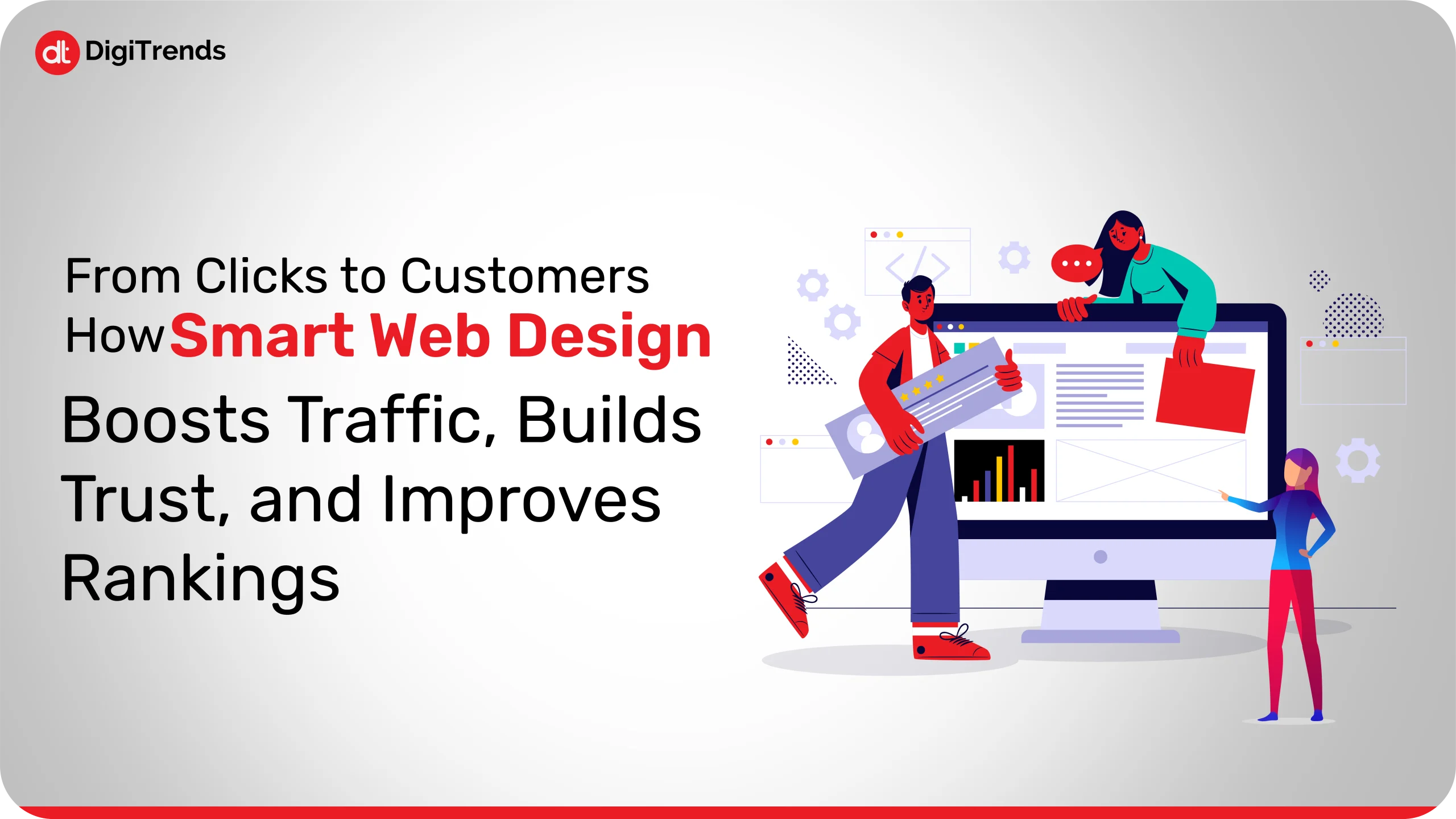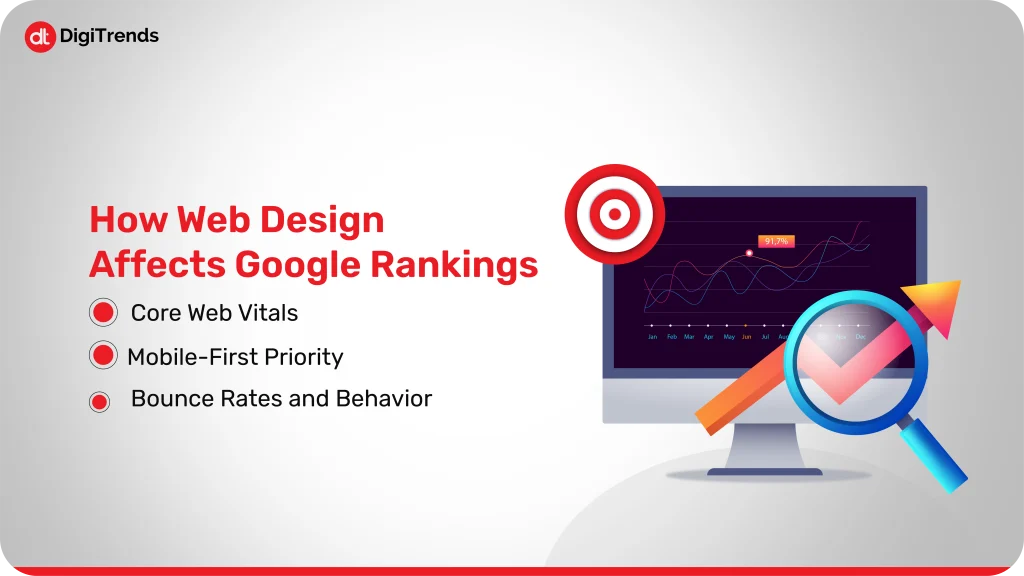
AI Reducing Healthcare Costs: Real Savings Backed by 7 Startup Case Studies
Look at the real numbers from healthcare organizations that show AI reducing healthcare costs in real. The AI lens makes costs look controllable.
Continue Reading
First impression is the last impression.
This statement is not only true for people but also for brands. Digital presence is what businesses rely on to connect with prospects.
The first interaction people have with a brand is often through their website. This makes the website not only a platform to showcase services, portfolio, and expertise but also a storefront and a salesperson. It won’t be wrong to say that the website of a brand plays a major role in building up the reputation of a customer.
But the challenge is not about building a website; it is about the design of the website. Visitors judge a website within seconds. If it is outdated, loads slowly, doesn’t match cultural expectations, is complex, or is not attractive, users leave the site. This is why smart web design for business has become essential.
Smart web design does not mean following the latest design trends and flashy visuals. It’s about creating an intuitive, functional site that is specifically created to cater to the goals of the business. It is a design that makes sense for users as well as the search engine. When web design for business is done well, it helps with Google ranking and conversions.
Explore the importance of smart web design for business growth, how design choices directly impact traffic and SEO rankings, the cultural dimension of websites in global markets, and practical techniques you can apply today.
Smart web design goes beyond aesthetics.
It refers to strategies that combine usability, cultural awareness, SEO, and conversions. Smart design can help businesses build experiences that turn traffic into revenue.
One of the core principles of smart web design is making sure the website is adaptable to every device, which means the website design should be responsive. A responsive web design automatically adjusts its layout, text, and images so they look and perform well on desktops, tablets, and smartphones. A site that fails to load or display properly on different devices is a site that loses traffic and credibility.
Another principle is conversion-focused web design. The website design should be intuitive, which means there should be a clear path with a simple call to action, simple navigation, and procedures that don’t ask for unnecessary information. The smoother the process, the higher the chances of turning clicks into customers.
Cultural web design is also an important part of smart web design, which is not a focus point for a lot of businesses, but businesses that design websites according to this concept have a competitive advantage.
A design that works well in the US may not resonate with audiences in the Middle East. For example, right-to-left layouts for Arabic, appropriate imagery, and color choices that align with local symbolism all play a role. When a website respects cultural norms, it feels more trustworthy and relatable, which directly boosts engagement.
Finally, there’s SEO-friendly architecture. Design alone is useless if people can’t find the website. Smart design also includes building a structure that search engines can easily crawl. This includes organized headings, optimized images, clean URLs, and fast-loading pages. These small technical details ensure the site not only looks good but also ranks well on Google.
Ever come across a website that has flashing animations, aesthetic designs, but it is so cluttered that you feel overwhelmed and exit?
That’s the problem with following trendy designs: it often sacrifices usability for a quick wow factor.
The approach of smart design is a little different. Smart web design doesn’t give up innovation and applies new ideas carefully, always keeping performance, trust, and user experience above flashy visuals.
Instead of gimmicks, smart design emphasizes balance. It is a perfect blend of modern visuals and practical elements like speed, accessibility, and conversions.
The result of smart design is a website that feels trendy but still delivers long-term value to both the business and its customers.

SEO is indeed a major factor in achieving website traffic growth, but design is also important in driving traffic. Let’s have a look:
A website’s structure also decides how Google analyzes and ranks it. Website design for SEO includes:
These steps directly affect the visibility of the website. A website designed with SEO in mind ranks higher and brings in more organic traffic.
Search engines like Google measure and rank websites according to the response they get from users. If the design of the website is slow and confusing, users bounce, which can harm the ranking. Smart layouts, simple navigation, and engaging visuals improve retention. This leads to website traffic growth not just from better rankings, but from users sharing and revisiting the site.
Traffic that doesn’t convert is wasted effort. A conversion-focused web design ensures visitors have a clear path. Whether that’s signing up for a demo, making a purchase, or contacting sales, the design should make the path smooth and intuitive.
When businesses design websites, it’s easy to focus only on functionality and aesthetics. But if a business is targeting a specific market, culture plays just as important a role.
Every market has its own expectations when it comes to visuals, colors, layouts, and even language. A design that works well for one region may not work for others, or even be off-putting to another.
For example, people in different cultures respond in different ways to some types of texts, colors, and images. Some cultures respond positively to minimal, text-heavy layouts, while others prefer vibrant visuals and interactive features. The way information is structured, linear, detailed, or more visual-first, can make the difference between a user staying engaged or leaving after a few seconds.
It is important for businesses targeting a specific region to include cultural factors in the website to emotionally connect with their audience. By aligning the design with the values and behaviors of the target audience, businesses create familiarity and trust.
People are more likely to engage with a site that “speaks their language” visually and contextually.

There are Google’s metrics like LCP, FID, and CLS that measure how fast and stable the website feels. Cluttered design slows load times and creates shifts that frustrate users. If the website is optimized for these vitals, there are increased chances of better ranking performance.
With most internet traffic in the world coming from mobile, responsive web design cannot be ignored, because a desktop-only site won’t rank well, no matter how polished it looks.
When design confuses users, they leave quickly. Google interprets high bounce rates as poor quality. This is why the importance of web design extends beyond looks; it impacts how search engines perceive relevance.
Now that you know the importance of web design for traffic, trust, and conversion, let’s have a look at the smart design techniques that work well.
Every delay on the website decreases conversion chances. Techniques for speed optimization include:
Fast sites not only please users but also align with website design for SEO.
A responsive web design ensures the site adjusts to any screen size. In mobile-first markets, a responsive web design is important. Techniques of achieving responsive design include fluid grids, flexible images, and testing across devices.
When designing the website, businesses should consider not overwhelming users with cluttered menus; instead, they should stick to simple, logical categories. A simple and clear design helps in user retention.
These techniques can be used to achieve a conversion-focused web design:
For websites, accessibility is optional; it is a very important factor, as if a website is not accessible, the bounce rates can increase. The techniques of increased website accessibility include:
Content hierarchy also plays an important part in achieving user retention and decreasing bounce rate, but is often ignored by businesses. Smart design guides users with a clear hierarchy. Large headlines grab attention, subheads explain details, and whitespace improves readability.
Together, these techniques turn smart web design into a growth engine and not just a visual upgrade.
Many companies invest heavily in ads and marketing, only to send visitors to poorly structured websites, which results in high bounce rates and wasted budgets.
DigiTrends’ approach to smart web design is business-first:
Unlike one-off designers, DigiTrends provides ongoing support. That means we support businesses in updating, testing, and optimizing their site as user behavior and search engines evolve.
For us smart design is a strategy, one we use to help businesses move from clicks to customers.

Web design isn’t decoration. It’s a strategy. Businesses in competitive markets can’t afford to treat their websites as afterthoughts. From speed and SEO to cultural alignment and trust, design choices shape how users and Google perceive your brand.
Smart web design is the foundation of growth. It brings in traffic, builds credibility, and improves rankings. When businesses get design right, clicks turn into loyal customers.